
|
Sale 78
January Pre-Long Beach Sale 17.5% BP
| Lot |
Photo |
Description |
Realized |
Lot 1842 |
|
1907 and 1911. Coins will both grade AU Details, Cleaned. Lot of 2 coins.
Estimated Value $1,200 - 1,250.
View details
| Realized
$1,439 |
Lot 1843 |
 |
1907. Wire Rim, Periods. PCGS graded MS-65+. CAC Approved. A magnificent example of Augustus Saint-Gaudens' newly designed gold eagle. The satin mint surfaces are undisturbed and exhibit rich golden mint bloom color. Only 500 minted of this popular first year variety. The year 1907 was a watershed one in American numismatics. Tossed out were several run-of-the-mill coin designs that had outlived their day. President "Teddy" Roosevelt, spearheaded the revolution by strong-arming the Mint to bring its coinage design up to twentieth century standards as he viewed things. America's brand-new navy, christened the Great White Fleet was steaming around the world on its grand tour as sort of a chest-pounding exercise. What better then for Theodore Roosevelt to be in the vanguard of this American "awakening" when it came to her coins. These elegant Indian Head Ten Dollar Pieces by Augustus Saint-Gaudens were one of the more visible signs of this modernization plan, and should be treasured accordingly as others cherish artifacts from prior, historic openings.
A rare and popular transitional issue, one of a mere 500 pieces made without intentions of circulation, technically making the Wire Edge $10 a pattern (Judd-1774). Some nowadays may argue the point of this being a true Pattern since some did reach circulation. This issue was the closest the mint came to reproducing the ten-dollar design as envisaged by Augustus Saint-Gaudens and Theodore Roosevelt. The presently offered coin has subtly variegated coloration but mainly warm mint bloom and only a few of the most inconsequential marks, none of them singular or important. The die polishing lines (universal to all specimens) are more pronounced on the reverse fields while overall the coin has a bright native satiny sheen. A humdinger of a coin, and a glorious Gem for the connoisseur and numismatic specialist who can afford this masterpiece of a bygone era! Pop 4; 21 finer, 15 in 66, 6 in 67 (PCGS # 8850) .
Historic note: Augustus Saint-Gaudens� (never omit the hyphen in his name, it isn�t polite to his memory) $10 design bore on the obverse a female wearing an Indian war bonnet, said to have been taken from the portrait of his mistress, Davida Clark, with whom he is alleged to have had a child (although biographers have never been able to confirm this). The bonnet or headdress is inscribed LIBERTY on a band, 13 stars are in an arc above, and the date is below.
The reverse depicts a perched eagle with UNITED STATES OF AMERICA above, the motto E PLURIBUS UNUM to the right, and the denomination expressed as TEN DOLLARS below. The eagle on the new 1907 $10 was directly copied from the motif Saint-Gaudens used on the 1905 presidential inaugural medal for Theodore Roosevelt. Later, Bela Lyon Pratt used pretty much the same motif for the reverse of the new $2.50 and $5 coins of 1908.
According to Bowers: "While these have been popularly called patterns, an examination of the situation leaves no room for any conclusion other than that these were 'special' coins produced not as patterns, but for the profit of Mint employees and favored others. A pattern is a design proposal made in very small numbers to test the motif -- often involving adjustments made by the engraver, etc., before coins are struck for circulation. In the present instance, the 'special' 1907 coins with periods were placed in the hands of Mint personnel who were free to keep them as souvenirs or sell them at a profit."
Estimated Value $60,000 - 65,000.
The Del Valle Collection.
View details and enlarged photos
Check results on similar lots
| Realized
$99,875 |
Lot 1844 |
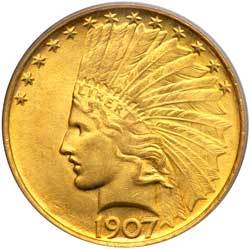 |
1907. No Motto. PCGS graded MS-64 PQ. Housed in an Old Green Holder. Lovely rich golden toning. Really needs to be regraded. This is a dazzling yellow-gold specimen burning with mint bloom, powerfully struck and preserved without a noticeable flaw. In the light of the churning mint bloom, collectors will like to hear that this piece is struck with exactitude rarely found on a No Motto $10 Indian.
Two limited-issue designs precede the 1907 "No Motto" Type; the design finally put into circulation is not technically Saint-Gaudens� at all, but is instead Barber's rendition of the Saint-Gaudens models. Not only is the relief somewhat flatter, but the triangular dots are omitted, the branch is differently formed, a curl trespasses on IBE, some letters are shaped in a different way, and feather ends are clearer -- though central hair and feathers show less definition. This type continued through part of 1908 (PCGS # 8852) .
Estimated Value $4,500 - 5,000.
View details and enlarged photos
Check results on similar lots
| Realized
$6,463 |
Lot 1845 |
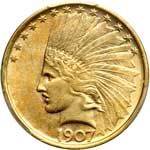 |
1907. No periods. PCGS graded AU-58. Lots of luster present (PCGS # 8852) .
Estimated Value $700 - 725.
View details and enlarged photos
Check results on similar lots
| Realized
$1,116 |
Lot 1846 |
 |
1908. With Motto. NGC graded AU-58. (PCGS # 8859) .
Estimated Value $700 - 725.
View details and enlarged photos
Check results on similar lots
| Realized
$1,028 |
Lot 1847 |
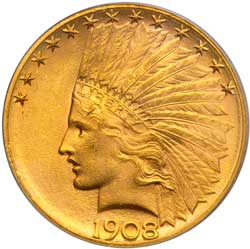 |
1908-S. With Motto. PCGS graded MS-64 PQ. Housed in an Old Green Holder. Only 59,850 minted. Rich golden toning on both sides. Nice eye appeal. Less than a year after adoption of the Saint-Gaudens $10, an upset Congress ordered that the motto IN GOD WE TRUST be restored, as mandated by the Act of March 3, 1865. The 1907 issues and the first ones of 1908 had lacked this motto. The new design with motto is by Charles E. Barber, after Saint-Gaudens. Aside from the addition of the motto, none of Barber's small changes are seen as improvements unless one notices that more of the first U of UNUM had to show. Striking quality remained the same.
Denver Mint coins 1908-10 continue the extra broad mintmark, tilted so as to follow the curve of border; later dates show a much smaller mintmark. S mintmarks are always small, also following the curve of border.
Coins dated 1908-11 have 46 stars on edge as before; 1912-33, 48 stars, the extra two being added to honor the admission of Arizona and New Mexico. Edges continued to be imparted by segmented (tripartite) collars. Pop 33; 35 finer (PCGS # 8861) .
Estimated Value $14,000 - 15,000.
View details and enlarged photos
Check results on similar lots
| Unsold |
Lot 1848 |
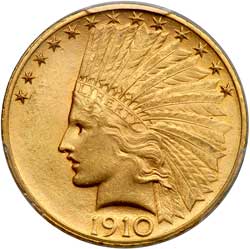 |
1910. PCGS graded MS-64. A nice frosty coin (PCGS # 8865) .
Estimated Value $1,500 - 1,550.
View details and enlarged photos
Check results on similar lots
| Realized
$2,291 |
Lot 1849 |
 |
1910-D. NGC graded MS-65. Well struck and untoned. Wonderful lustrous surfaces are flourishing with gem quality gold and iridescent brilliance. Exceptional detail for the date. This includes all reverse details present, indeed something reaching "full strike" can be said. Fully struck coins of this year and mint are elusive. Pop 182; 47 finer, 2 in 65+, 33 in 66, 5 in 66+, 7 in 67. (PCGS # 8866) .
The Census for 1910 reported the U.S. population as 91,972,266. An obscure British music-hall performer with a French kick toured the U.S. with a pantomime troupe this year, and appeared in a vaudeville act billed as "Karno's Wow Wows." His name: Charlie Chaplin.
Estimated Value $7,000 - 7,500.
View details and enlarged photos
Check results on similar lots
| Unsold |
Lot 1850 |
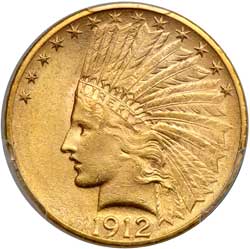 |
1912. PCGS graded MS-62. Lightly toned (PCGS # 8871) .
Estimated Value $700 - 725.
View details and enlarged photos
Check results on similar lots
| Realized
$1,028 |
Lot 1851 |
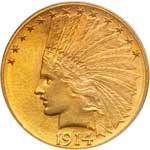 |
1914-D. PCGS graded MS-64. Nice shades of golden toning. Well struck. A satiny specimen, right on the cusp of Gem MS65 level, with energetic luster and pleasing color that seems to want to motivate bidders to left their bids as though by subtle hypnosis! Pop 200; 41 finer at PCGS. (PCGS # 8876) .
Historic Note: In the summer of 1914, war broke out in Europe between contending alliances. This had the effect of upsetting the money markets and in particular gold, the basis of all money standards in those days. The U.S. government, which wasn't a participant in 1914, had to take measures to insure that the country was not drained of its gold. The stock exchange was closed for 5 months beginning in Aug. 1914; bond markets ceased operating. However, by late in the Fall and early Winter, a situation the opposite to the one feared developed. The belligerent nations began to flood the United States with their gold to pay for supplies and to secure a safe haven from looting. The crisis eased and the United States began a wildly profitable war-induced boom phase that lasted until 1918-19.
Estimated Value $3,300 - 3,500.
View details and enlarged photos
Check results on similar lots
| Unsold |
Lot 1852 |
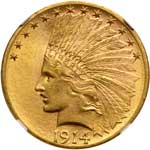 |
1914-D. NGC graded MS-63. A nice frosty coin. A hint of light rose tone. Scarcer than most dates in this series in Choice condition, The two issues struck in 1914 (Philadelphia and Denver) along with the key date 1911-D, are the scarcest years in the 15-coin set (PCGS # 8876) .
Estimated Value $1,700 - 1,800.
View details and enlarged photos
Check results on similar lots
| Realized
$3,290 |
Lot 1853 |
 |
1920-S. PCGS graded AU-55. An important rarity in the $10 Indian series. A pleasing looking example for the grade boasting a decent strike, lacking the "TY" in Liberty which is always the case. Enough remaining mint luster to justify the given grade. Identified by a nick at Liberty's chin. Delicate light golden in color throughout. Pop 11; 36 finer
This date is legendary among modern collectors. In associations with 1930-S and 1933, it is one of three prime Indian Head Eagle rarities. It has been surmised that most 1920-S Eagles were retained in commercial banks, the Treasury (as backing for Gold Certificate currency), and in Federal Reserve vaults. Few were loose in circulation between the time they were minted and the summer of 1933, when President Franklin D. Roosevelt nationalized the privately owned gold and had it transferred to the Treasury. Very few 1920-S Eagles reached circulation. The majority, sadly, were melted down and cast into 400-ounce "coin melt" gold bars. This great melting took place in 1934-37 under the supervision of Nellie Tayloe Ross, director of the Mint, 1933-53. The resulting coin-melt bars were then stored in the newly constructed Fort Knox made for that purpose, an army base in Kentucky. A bare handful of the 1920-S issue escaped this fate.
Since at least the 1930s, the 1920-S eagle has been known and recognized as a key date and, by the time of the publication of the first edition of the Red Book in 1947, the 1920-S was already placed along with the 1930-S for its position of third rarest issue of the series after the 1907 Rolled Edge and 1933. (It is significant that after 60 years, the top four population rarities of the series have kept their relative positions, although the 1920-S is now accepted to be much rarer than the 1930-S in all grades.) The mintage of 126,500 pieces, although somewhat low, barely places the 1920-S in the top 10 lowest mintage regular issues of the series. However, its survival rate obviously has been extremely low in light of the information provided above (PCGS # 8881) .
Estimated Value $20,000 - 22,000.
Ex: Purchased from Abner Kreisberg in the 1970's The Del Valle Collection.
View details and enlarged photos
Check results on similar lots
| Realized
$44,650 |
Lot 1854 |
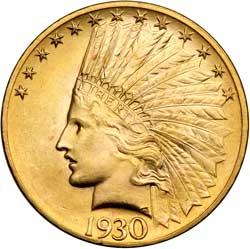 |
1930-S. PCGS graded MS-65. CAC Approved. As fresh as the day it was minted! Well struck and sparkling with intense mint luster boasting natural golden bloom colors. The cheek is remarkably clean and thus clearly justifies the CAC sticker. This gem has not been outside of the safe deposit box for nearly 50 years!
As America's circulating $10 gold production declined throughout the 1920s and the Great Depression tightened its grip, San Francisco's output became gradually more erratic. The West Coast coin factory was the only site to strike Eagles in 1916. No U.S. gold coins were struck for circulation in 1917-19. Afterward, while twenty dollar output remained high in the 1920s at all three Mints, the end of the ten dollar denomination was fitful, with a ten years hiatus between the famous 1920-S Eagles and the 1930-S pieces, except for a lone high production Philadelphia issue in 1926. The Eagles and Double Eagles minted at San Francisco in 1930 would be the last U.S. gold coins struck at that Mint until 1984.
The 1930-S Eagles, already few in number from the low mintage of 96,000 struck, was reduced further by the gold meltings of the Roosevelt Administration. The vast majority of survivors are in varying degrees of Mint State, indicating an issue that met the same fate as many of the other melt rarities of the period. Garrett and Guth, in their Encyclopedia of U.S. Gold Coins, write: "In overall terms of rarity, this date ranks a little behind the 1920-S, with just a few hundred known in all, and those are scattered over the grading spectrum."
Most 1930-S specimens share certain physical traits. When seen, the 1930-S tends to be thickly frosted, a common trait on S-mint tens in this series. Also, the color is often vibrant yellow to greenish gold with pinkish overtones present on many of the highest-graded examples. This handsome gem 1930-S illustrates the point exactly! Pop 14; 7 finer, 1 in 65+, 5 in 66, 1 in 67 (PCGS # 8883) .
Estimated Value $50,000 - 60,000.
The Del Valle Collection.
View details and enlarged photos
Check results on similar lots
| Realized
$79,313 |
Lot 1855 |
|
1880 $5 and 1881 $10 gold coins. Sharpness of VF and worn as jewelry. Lot of 2 coins.
Estimated Value $800 - 850.
View details
| Realized
$1,087 |
|
|